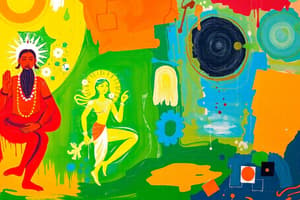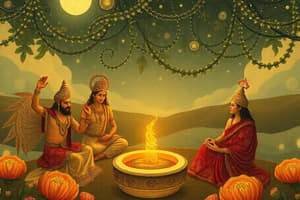Podcast
Questions and Answers
What are the six orthodox schools of Hindu philosophy called?
What are the six orthodox schools of Hindu philosophy called?
- Vedanta
- Shaivism
- Samkhya
- Vaisheshika (correct)
- Mimamsa
- Nyaya
Which school of Hindu philosophy focuses on logic, methodology, and epistemology?
Which school of Hindu philosophy focuses on logic, methodology, and epistemology?
- Vaisheshika
- Samkhya
- Nyaya (correct)
- Yoga
Which school of Hindu philosophy emphasizes hermeneutics, exegesis, and the metaphysics of dharma?
Which school of Hindu philosophy emphasizes hermeneutics, exegesis, and the metaphysics of dharma?
- Nyaya
- Samkhya
- Vedanta
- Mimamsa (correct)
Which sub-school of Vedanta advocates spiritual and universal non-dualism?
Which sub-school of Vedanta advocates spiritual and universal non-dualism?
What is the philosophy of qualified non-dualism that sees Brahman as an eternal oneness and the source of all creation called?
What is the philosophy of qualified non-dualism that sees Brahman as an eternal oneness and the source of all creation called?
Which school of thought in Hinduism emphasizes materialism, philosophical skepticism, and empiricism?
Which school of thought in Hinduism emphasizes materialism, philosophical skepticism, and empiricism?
Which school of Shaivism is the oldest of the major Shaiva schools and was systematized by Lakulish in the 2nd century CE?
Which school of Shaivism is the oldest of the major Shaiva schools and was systematized by Lakulish in the 2nd century CE?
Which school of Shaivism arose during the eighth or ninth century CE in Kashmir and is categorised by various scholars as monistic idealism?
Which school of Shaivism arose during the eighth or ninth century CE in Kashmir and is categorised by various scholars as monistic idealism?
What does the Cārvāka epistemology state about inferred knowledge?
What does the Cārvāka epistemology state about inferred knowledge?
Flashcards
Ṣaḍdarśana
Ṣaḍdarśana
Six orthodox schools of Hindu philosophy: Samkhya, Yoga, Nyaya, Vaisheshika, Mimamsa, and Vedanta.
Yoga Philosophy
Yoga Philosophy
Philosophical system closely aligned with the dualist premises of the Samkhya school.
Nyāya School
Nyāya School
Hindu school focusing on epistemology and reliable means of gaining correct knowledge.
Mīmāṃsā School
Mīmāṃsā School
Signup and view all the flashcards
Vedanta School
Vedanta School
Signup and view all the flashcards
Advaita
Advaita
Signup and view all the flashcards
Shaivism
Shaivism
Signup and view all the flashcards
Pāśupata Shaivism
Pāśupata Shaivism
Signup and view all the flashcards
Cārvāka
Cārvāka
Signup and view all the flashcards
Study Notes
Various Systems of Thought in Hinduism:
-
Hindu philosophy includes six systems (shad-darśana) – Samkhya, Yoga, Nyaya, Vaisheshika, Mimamsa, and Vedanta.
-
Nāstika Indian philosophies include Buddhism, Jainism, Chārvāka, Ājīvika, and others.
-
Western scholars have debated the relationship and differences within āstika philosophies and with nāstika philosophies.
-
Hindu philosophy also includes several sub-schools of theistic philosophies that integrate ideas from two or more of the six orthodox philosophies.
-
Each school of Hindu philosophy has extensive epistemological literature called Pramana, as well as theories on metaphysics, axiology, and other topics.
-
The orthodox schools of Indian philosophy have been called ṣaḍdarśana ('six systems').
-
There are six āstika (orthodox) schools of thought and four nāstika (heterodox) schools of thought.
-
The Yoga philosophical system aligns closely with the dualist premises of the Samkhya school.
-
The Vaiśeṣika philosophy is a naturalist school, a form of atomism in natural philosophy.
-
The Nyāya school is a realist āstika philosophy, with its most significant contributions to Indian philosophy being its systematic development of the theory of logic, methodology, and its treatises on epistemology.
-
Nyāya epistemology accepts four out of six means of gaining knowledge as reliable.
-
Samkhya is the oldest of the orthodox philosophical systems in Hinduism, with origins in the 1st millennium BCE.Overview of Hindu Philosophical Schools
-
Nyāya school focuses on epistemology and reliable means of gaining correct knowledge.
-
Mīmāṃsā school emphasizes hermeneutics, exegesis, and the metaphysics of dharma.
-
Vedanta school is the most developed and best-known of the Hindu schools, building upon the teachings of the Upanishads and Brahma Sutras.
-
Advaita is a sub-school of Vedanta that asserts spiritual and universal non-dualism.
-
Viśiṣṭādvaita is a philosophy of qualified non-dualism that sees Brahman as an eternal oneness and the source of all creation.
-
Dvaita is a theistic sub-school in Vedanta tradition that believes in the existence of two separate realities: God and individual Selfs.
-
Dvaitādvaita proposes that there are three categories of existence: Brahman, Self, and matter, which are separate yet dependent.
-
Śuddhādvaita is the philosophy of purely non-dualism, which sees Brahman as the creator of the world without connection to any external agency.
-
Acintya Bheda Abheda proposes that the Self or energy of God is both distinct and non-distinct from God.
-
Cārvāka is an atheistic school of thought that emphasizes materialism, philosophical skepticism, and empiricism.Overview of Shaivism Philosophy
-
Shaivism is a philosophical school of Hinduism, which recognizes Lord Shiva as the Supreme Being or the Ultimate Reality.
-
Shaivism is represented by various philosophical schools, including non-dualist (abheda), dualist (bheda), and non-dualist-with-dualist (bhedābheda) perspectives.
-
Pāśupata Shaivism (Pāśupata, 'of Paśupati') is the oldest of the major Shaiva schools. The philosophy of Pashupata sect was systematized by Lakulish in the 2nd century CE.
-
Shaiva Siddhanta provides the normative rites, cosmology and theological categories of Tantric Shaivism. Being a dualistic philosophy, the goal of Shaiva Siddhanta is to become an ontologically distinct Shiva (through Shiva's grace).
-
Kashmir Shaivism arose during the eighth or ninth century CE in Kashmir and is categorised by various scholars as monistic idealism.
-
Kashmir Shaivism holds that all things are a manifestation of Universal Consciousness and the phenomenal world (Śakti) is real, and it exists and has its being in Consciousness (Chit).
-
The objective of human life, according to Kashmir Shaivism, is to merge in Shiva or Universal Consciousness, or to realize one's already existing identity with Shiva, by means of wisdom, yoga and grace.
-
The Cārvāka epistemology states that whenever one infers a truth from a set of observations or truths, one must acknowledge doubt; inferred knowledge is conditional.
-
The insentient was further divided into effects and causes. The effects were of ten kinds, the earth, four elements and their qualities, colour etc. The causes were of thirteen kinds, the five organs of cognition, the five organs of action, the three internal organs, intellect, the ego principle and the cognising principle.
-
According to Pāśupatas, Self possesses the attributes of the Supreme Deity when it becomes liberated from the 'germ of every pain'.
-
Shaivism is difficult to trace back to its origins; however, the Śvetāśvatara Upanishad (400 – 200 BCE) is considered to be the earliest textual exposition of a systematic philosophy of Shaivism.
-
Vidyaranya in his works mentions three major schools of Shaiva thought: Pashupata Shaivism, Shaiva Siddhanta and Pratyabhijña (Kashmir Shaivism).
-
Advaita Vedanta and Kashmir Shaivism are non-dual philosophies, but in Kashmir Shavisim, all things are a manifestation of this Consciousness as opposed to Advaita, which holds that Brahman is the reality and the phenomenal world is an appearance.
Studying That Suits You
Use AI to generate personalized quizzes and flashcards to suit your learning preferences.




